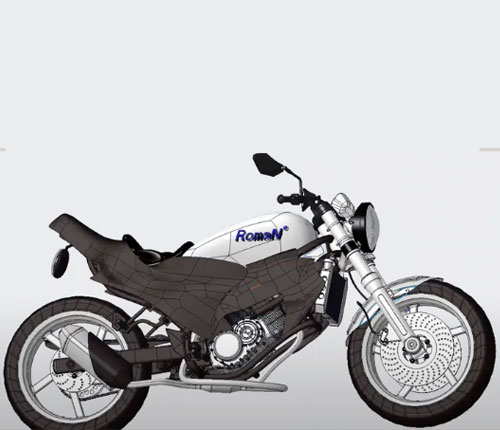Designing a Full Motorcycle using CREO

Design and develop a high-performance motorcycle using AutoCAD, incorporating innovation, aesthetics, and engineering excellence.
Background: As a passionate motorcycle enthusiast and mechanical engineering graduate, I embarked on the exciting journey of creating a unique and powerful motorcycle design. Leveraging the capabilities of AutoCAD, I aimed to blend cutting-edge technology with an aesthetically pleasing design.
Methodology:
- Conceptualization:
- Conducted market research to identify current trends and customer preferences.
- Brainstormed and sketched multiple design concepts, considering aerodynamics, ergonomics, and structural integrity.
- AutoCAD Modeling:
- Utilized AutoCAD’s 3D modeling capabilities to create a detailed digital representation of the motorcycle.
- Incorporated parametric design to facilitate quick adjustments and iterations.
- Ensured precision in measurements for every component, from the chassis to the smallest details.
- Dynamic Analysis:
- Performed finite element analysis (FEA) within AutoCAD to assess structural integrity and identify potential stress points.
- Simulated dynamic scenarios to evaluate the motorcycle’s performance under various conditions, ensuring stability and safety.
- Integration of Innovative Features:
- Integrated advanced features, such as smart LED lighting, a digitally controlled engine management system, and aerodynamic enhancements.
- Ensured seamless integration of electronic components into the overall design.
- Collaboration and Feedback:
- Engaged with a multidisciplinary team to gather input and feedback on the design.
- Conducted design reviews to address concerns and refine the motorcycle’s performance and aesthetics.
Results:
- High-Performance Design:
- Achieved a streamlined and aerodynamic design, optimizing the motorcycle for speed and maneuverability.
- Integrated a powerful yet efficient engine to deliver exceptional performance.
- Innovative Features:
- Successfully incorporated advanced features, enhancing the motorcycle’s safety, connectivity, and user experience.
- Established a balance between technological innovation and classic motorcycle design elements.
- Engineering Excellence:
- The use of AutoCAD allowed for a seamless transition from concept to a detailed, manufacturable design.
- Structural analysis ensured the motorcycle met safety standards and provided a robust foundation for future iterations.
Conclusion: The motorcycle design created in AutoCAD represents a harmonious blend of aesthetics, innovation, and engineering precision. This case study highlights the versatility of AutoCAD in transforming conceptual ideas into tangible, high-performance products. The motorcycle stands as a testament to the commitment to excellence and the continuous pursuit of pushing the boundaries in the field of mechanical engineering